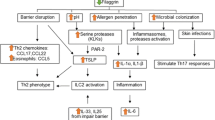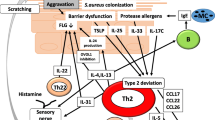Abstract
Prior studies revealed the key roles played by T-helper type 1 and type 2 (Th1/Th2) cell dysregulation, IgE production, mast cell hyperactivity, and dendritic cell signaling in the evolution of the chronic, pruritic, inflammatory dermatosis that characterizes atopic dermatitis (AD). Accordingly, current therapy has been largely directed toward ameliorating Th2-mediated inflammation and pruritus. This article reviews emerging evidence that the inflammation in AD results from inherited and acquired insults to the barrier, as well as the therapeutic implications of this new paradigm.
Similar content being viewed by others
References and Recommended Reading
Sugarman JL, Fluhr JW, Fowler AJ, et al.: The objective severity assessment of atopic dermatitis score: an objective measure using permeability barrier function and stratum corneum hydration with computer-assisted estimates for extent of disease. Arch Dermatol 2003, 139:1417–1422.
Seidenari S, Giusti G: Objective assessment of the skin of children affected by atopic dermatitis: a study of pH, capacitance and TEWL in eczematous and clinically uninvolved skin. Acta Derm Venereol 1995, 75:429–433.
Proksch E, Folster-Holst R, Jensen JM: Skin barrier function, epidermal proliferation and differentiation in eczema. J Dermatol Sci 2006, 43:159–169.
Chamlin SL, Kao J, Frieden IJ, et al.: Ceramide-dominant barrier repair lipids alleviate childhood atopic dermatitis: changes in barrier function provide a sensitive indicator of disease activity. J Am Acad Dermatol 2002, 47:198–208.
Baker BS: The role of microorganisms in atopic dermatitis. Clin Exp Immunol 2006, 144:1–9.
Elias PM, Wood LC, Feingold KR: Epidermal pathogenesis of inflammatory dermatoses. Am J Contact Dermat 1999, 10:119–126.
Elias PM, Feingold KR: Does the tail wag the dog? Role of the barrier in the pathogenesis of inflammatory dermatoses and therapeutic implications. Arch Dermatol 2001, 137:1079–1081.
Taieb A: Hypothesis: from epidermal barrier dysfunction to atopic disorders. Contact Dermatitis 1999, 41:177–180.
Grimalt R, Mengeaud V, Cambazard F: The steroid-sparing effect of an emollient therapy in infants with atopic dermatitis: a randomized controlled study. Dermatology 2007, 214:61–67.
Elias PM: Stratum corneum defensive functions: an integrated view. J Invest Dermatol 2005, 125:183–200.
Elias PM: The skin barrier as an innate immune element. Semin Immunopathol 2007, 29:3–14.
Caubet C, Jonca N, Brattsand M, et al.: Degradation of corneodesmosome proteins by two serine proteases of the kallikrein family, SCTE/KLK5/hK5 and SCCE/KLK7/hK7. J Invest Dermatol 2004, 122:1235–1244.
Brattsand M, Stefansson K, Lundh C, et al.: A proteolytic cascade of kallikreins in the stratum corneum. J Invest Dermatol 2005, 124:198–203.
Braff MH, Di Nardo A, Gallo RL: Keratinocytes store the antimicrobial peptide cathelicidin in lamellar bodies. J Invest Dermatol 2005, 124:394–400.
Oren A, Ganz T, Liu L, Meerloo T: In human epidermis, beta-defensin 2 is packaged in lamellar bodies. Exp Mol Pathol 2003, 74:180–182.
Walley AJ, Chavanas S, Moffatt MF, et al.: Gene polymorphism in Netherton and common atopic disease. Nat Genet 2001, 29:175–178.
Hachem JP, Wagberg F, Schmuth M, et al.: Serine protease activity and residual LEKTI expression determine phenotype in Netherton syndrome. J Invest Dermatol 2006, 126:1609–1621.
Vasilopoulos Y, Cork MJ, Murphy R, et al.: Genetic association between an AACC insertion in the 3’UTR of the stratum corneum chymotryptic enzyme gene and atopic dermatitis. J Invest Dermatol 2004, 123:62–66.
Hubiche T, Ged C, Benard A, et al.: Analysis of SPINK 5, KLK 7 and FLG genotypes in a french atopic dermatitis cohort. Acta Derm Venereol 2007, 87:499–505.
Folster-Holst R, Stoll M, Koch WA, et al.: Lack of association of SPINK5 polymorphisms with nonsyndromic atopic dermatitis in the population of Northern Germany. Br J Dermatol 2005, 152:1365–1367.
Weidinger S, Baurecht H, Wagenpfeil S, et al.: Analysis of the individual and aggregate genetic contributions of previously identified serine peptidase inhibitor Kazal type 5 (SPINK5), kallikrein-related peptidase 7 (KLK7), and filaggrin (FLG) polymorphisms to eczema risk. J Allergy Clin Immunol 2008, 122:560–568.e4.
Hachem JP, Crumrine D, Fluhr J, et al.: pH directly regulates epidermal permeability barrier homeostasis, and stratum corneum integrity/cohesion. J Invest Dermatol 2003, 121:345–353.
Di Nardo A, Wertz P, Giannetti A, Seidenari S: Ceramide and cholesterol composition of the skin of patients with atopic dermatitis. Acta Derm Venereol 1998, 78:27–30.
Imokawa G, Abe A, Jin K, et al.: Decreased level of ceramides in stratum corneum of atopic dermatitis: an etiologic factor in atopic dry skin? J Invest Dermatol 1991, 96:523–526.
Hachem JP, Houben E, Crumrine D, et al.: Serine protease signaling of epidermal permeability barrier homeostasis. J Invest Dermatol 2006, 126:2074–2086.
Sator PG, Schmidt JB, Honigsmann H: Comparison of epidermal hydration and skin surface lipids in healthy individuals and in patients with atopic dermatitis. J Am Acad Dermatol 2003, 48:352–358.
Irvine AD, McLean WH: Breaking the (un)sound barrier: filaggrin is a major gene for atopic dermatitis. J Invest Dermatol 2006, 126:1200–1202.
Hudson TJ: Skin barrier function and allergic risk. Nat Genet 2006, 38:399–400.
Fleckman P, Brumbaugh S: Absence of the granular layer and keratohyalin define a morphologically distinct subset of individuals with ichthyosis vulgaris. Exp Dermatol 2002, 11:327–336.
Howell MD, Kim BE, Gao P, et al.: Cytokine modulation of atopic dermatitis filaggrin skin expression. J Allergy Clin Immunol 2007, 120:150–155.
Bieber T: Atopic dermatitis. N Engl J Med 2008, 358:1483–1494.
O’Regan GM, Sandilands A, McLean WH, Irvine AD: Filaggrin in atopic dermatitis. J Allergy Clin Immunol 2008, 122:689–693.
Sandilands A, Smith FJ, Irvine AD, McLean WH: Filaggrin’s fuller figure: a glimpse into the genetic architecture of atopic dermatitis. J Invest Dermatol 2007, 127:1282–1284.
Lynley AM, Dale BA: The characterization of human epidermal filaggrin. A histidine-rich, keratin filament-aggregating protein. Biochim Biophys Acta 1983, 744:28–35.
Harding CR, Scott IR: Histidine-rich proteins (filaggrins): structural and functional heterogeneity during epidermal differentiation. J Mol Biol 1983, 170:651–673.
Fleckman P, Dale BA, Holbrook KA: Profilaggrin, a high-molecular-weight precursor of filaggrin in human epidermis and cultured keratinocytes. J Invest Dermatol 1985, 85:507–512.
Takahashi M, Tezuka T, Katunuma N: Filaggrin linker segment peptide and cystatin alpha are parts of a complex of the cornified envelope of epidermis. Arch Biochem Biophys 1996, 329:123–126.
Steinert PM, Marekov LN: The proteins elafin, filaggrin, keratin intermediate filaments, loricrin, and small proline-rich proteins 1 and 2 are isodipeptide cross-linked components of the human epidermal cornified cell envelope. J Biol Chem 1995, 270:17702–17711.
Scott IR, Harding CR, Barrett JG: Histidine-rich protein of the keratohyalin granules. Source of the free amino acids, urocanic acid and pyrrolidone carboxylic acid in the stratum corneum. Biochim Biophys Acta 1982, 719:110–117.
Rawlings AV, Scott IR, Harding CR, Bowser PA: Stratum corneum moisturization at the molecular level. J Invest Dermatol 1994, 103:731–741.
Abe T, Ohkido M, Yamamoto K: Studies on skin surface barrier functions: skin surface lipids and transepidermal water loss in atopic skin during childhood. J Dermatol 1978, 5:223–229.
Werner Y, Lindberg M: Transepidermal water loss in dry and clinically normal skin in patients with atopic dermatitis. Acta Derm Venereol 1985, 65:102–105.
Fartasch M, Diepgen TL: The barrier function in atopic dry skin. Disturbance of membrane-coating granule exocytosis and formation of epidermal lipids? Acta Derm Venereol Suppl (Stockh) 1992, 176:26–31.
Scott IR, Harding CR: Filaggrin breakdown to water binding compounds during development of the rat stratum corneum is controlled by the water activity of the environment. Dev Biol 1986, 115:84–92.
Krien P, Kermici M: Evidence for the existence of a self-regulated enzymatic process within human stratum corneum-an unexpected role for urocanic acid. J Invest Dermatol 2000, 115:414–420.
Nylander-Lundqvist E, Back O, Egelrud T: IL-1 beta activation in human epidermis. J Immunol 1996, 157:1699–1704.
Bisgaard H, Simpson A, Palmer CN, et al.: Gene-environment interaction in the onset of eczema in infancy: filaggrin loss-of-function mutations enhanced by neonatal cat exposure. PLoS Med 2008, 5:e131.
Jeong SK, Kim HJ, Youm JK, et al.: Mite and cockroach allergens activate protease-activated receptor 2 and delay epidermal permeability barrier recovery. J Invest Dermatol 2008, 128:1930–1939.
Novak N, Baurecht H, Schafer T, et al.: Loss-of-function mutations in the filaggrin gene and allergic contact sensitization to nickel. J Invest Dermatol 2008, 128:1430–1435.
Schlievert PM, Case LC, Strandberg KL, et al.: Superantigen profile of Staphylococcus aureus isolates from patients with steroid-resistant atopic dermatitis. Clin Infect Dis 2008, 46:1562–1567.
Aberg KM, Man MQ, Gallo RL, et al.: Co-regulation and interdependence of the mammalian epidermal permeability and antimicrobial barriers. J Invest Dermatol 2008, 128:917–925.
Cork MJ, Robinson DA, Vasilopoulos Y, et al.: New perspectives on epidermal barrier dysfunction in atopic dermatitis: gene-environment interactions. J Allergy Clin Immunol 2006, 118:3–21; quiz 22–23.
Garg A, Chren MM, Sands LP, et al.: Psychological stress perturbs epidermal permeability barrier homeostasis: implications for the pathogenesis of stress-associated skin disorders. Arch Dermatol 2001, 137:53–59.
Kurahashi R, Hatano Y, Katagiri K: IL-4 suppresses the recovery of cutaneous permeability barrier functions in vivo. J Invest Dermatol 2008, 128:1329–1331.
Altrichter S, Kriehuber E, Moser J, et al.: Serum IgE autoantibodies target keratinocytes in patients with atopic dermatitis. J Invest Dermatol 2008, 128:2232–2239.
Ong PY, Ohtake T, Brandt C, et al.: Endogenous antimicrobial peptides and skin infections in atopic dermatitis. N Engl J Med 2002, 347:1151–1160.
Miller SJ, Aly R, Shinefeld HR, Elias PM: In vitro and in vivo antistaphylococcal activity of human stratum corneum lipids. Arch Dermatol 1988, 124:209–215.
Bibel DJ, Aly R, Shinefield HR: Antimicrobial activity of sphingosines. J Invest Dermatol 1992, 98:269–273.
Nomura I, Goleva E, Howell MD, et al.: Cytokine milieu of atopic dermatitis, as compared to psoriasis, skin prevents induction of innate immune response genes. J Immunol 2003, 171:3262–3269.
Lomholt H, Andersen KE, Kilian M: Staphylococcus aureus clonal dynamics and virulence factors in children with atopic dermatitis. J Invest Dermatol 2005, 125:977–982.
Wehner J, Neuber K: Staphylococcus aureus enterotoxins induce histamine and leukotriene release in patients with atopic eczema. Br J Dermatol 2001, 145:302–305.
Leung DY, Harbeck R, Bina P, et al.: Presence of IgE antibodies to staphylococcal exotoxins on the skin of patients with atopic dermatitis. Evidence for a new group of allergens. J Clin Invest 1993, 92:1374–1380.
Sonkoly E, Muller A, Lauerma AI, et al.: IL-31: a new link between T cells and pruritus in atopic skin inflammation. J Allergy Clin Immunol 2006, 117:411–417.
Mazereeuw-Hautier J, Cope J, Ong C, et al.: Topical recombinant alpha1-antitrypsin: a potential treatment for Netherton syndrome? Arch Dermatol 2006, 142:396–398.
Sugarman J, Parish LJ: A topical lipid-based barrier repair formulation (EpiCeram cream) is high-effective monotherapy for moderate-to-severe pediatric atopic dermatitis. Presented at the IID Meeting 2008. Kyoto, Japan; May 14–17, 2008.
Galli SJ, Tsai M, Piliponsky AM: The development of allergic inflammation. Nature 2008, 454:445–454.
De Benedetto A, Qualia CM, Baroody FM, Beck LA: Filaggrin expression in oral, nasal, and esophageal mucosa. J Invest Dermatol 2008, 128:1594–1597.
Elias PM, Hatano Y, Williams ML: Basis for the barrier abnormality in atopic dermatitis: outside-inside-outside pathogenic mechanisms. J Allergy Clin Immunol 2008, 121:1337–1343.
Author information
Authors and Affiliations
Corresponding author
Rights and permissions
About this article
Cite this article
Elias, P.M., Schmuth, M. Abnormal skin barrier in the etiopathogenesis of atopic dermatitis. Curr Allergy Asthma Rep 9, 265–272 (2009). https://doi.org/10.1007/s11882-009-0037-y
Published:
Issue Date:
DOI: https://doi.org/10.1007/s11882-009-0037-y




